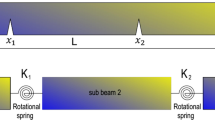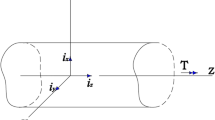Abstract
The reliability of a complex mathematical problem is presented in this work. The problem is a rupture concrete beam reinforced by steel fibers with various orientation angle. The structure is simulated by sinusoidal shear deformation theory and energy method. Harmonic differential quadrature method is applied for the solution of the problem under the buckling load. The reliability analysis of the mentioned system is studied utilizing a three-term conjugate finite-step length (TCFS) approach. The TCFS is formulated utilizing the conjugate gradient method with a limited scalar parameter to reach the numerical stabilization. The implicit buckling limit state function of the structure includes different parameters of length to thickness ratio of the beam, volume percent and orientation angle of steel fibers, rupture constant and boundary conditions. The results show that the failure probabilities of the studied structure may be decreased by increasing the rupture constant. In addition, the orientation angle of zero is the best choice for steel fiber in the concrete beam.







Similar content being viewed by others
References
Wuite J, Adali S (2005) Deflection and stress behaviour of nanocomposite reinforced beams using a multiscale analysis. Compos Struct 71:388–396
Vodenitcharova T, Zhang LC (2006) Bending and local buckling of a nanocomposite beam reinforced by a single-walled carbon nanotube. Int J Solids Struct 43:3006–3024
Civalek Ö (2007) Numerical analysis of free vibrations of laminated composite conical and cylindrical shells: discrete singular convolution (DSC) approach. Comput Appl Math 205:251–271
Shen HS (2009) Nonlinear bending of functionally graded carbon nanotube reinforced composite plates in thermal environments. Compos Struct 91(1):9–19
Shen HS, Zhang CL (2010) Thermal buckling and postbuckling behavior of functionally graded carbon nanotube-reinforced composite plates. Mater Des 31(7):3403–3411
Yas MH, Heshmati M (2012) Dynamic analysis of functionally graded nanocomposite beams reinforced by randomly oriented carbon nanotube under the action of moving load. Appl Math Model 36(4):1371–1394
Sobhani Aragh BS, Barati AHNH H (2012) Eshelby–Mori–Tanaka approach for vibrational behavior of continuously graded carbon nanotube-reinforced cylindrical panels. Compos Part B 43(4):1943–1954
Rafiee M, Yang J, Kitipornchai S (2013) Thermal bifurcation buckling of piezoelectric carbon nanotube reinforced composite beams. Comput Math Appl 66(7):1147–1160
Wattanasakulpong N, Ungbhakorn V (2013) Analytical solutions for bending, buckling and vibration responses of carbon nanotube-reinforced composite beams resting on elastic foundation. Comput Mater Sci 71:201–208
Lin F, Xiang Y (2014) Vibration of carbon nanotube reinforced composite beams based on the first and third order beam theories. Appl Math Model 38(15–16):3741–3754
Borbón F, Ambrosini D, Curadelli O (2014) Damping response of composites beams with carbon nanotubes. Compos B Eng 60:106–110
Wu CP, Lai WW (2015) Free vibration of an embedded single-walled carbon nanotube with various boundary conditions using the RMVT-based nonlocal Timoshenko beam theory and DQ method. Phys E Low Dimens Syst Nanostruct 68:8–21
Kolahchi R, Rabani Bidgoli M, Beygipoor G, Fakhar MH (2015) A nonlocal nonlinear analysis for buckling in embedded FG-SWCNT-reinforced microplates subjected to magnetic field. J Mech Sci Technol 29(9):3669–3677
Wu HL, Yang J, Kitipornchai S (2016) Nonlinear vibration of functionally graded carbon nanotube-reinforced composite beams with geometric imperfections. Compos Part B 90:86–96
Kolahchi R, Safari M, Esmailpour M (2016) Dynamic stability analysis of temperature-dependent functionally graded CNT-reinforced visco-plates resting on orthotropic elastomeric medium. Compos Struct 150:255–265
Mosharrafian F, Kolahchi R (2016) Nanotechnology, smartness and orthotropic nonhomogeneous elastic medium effects on buckling of piezoelectric pipes. Struct Eng Mech 58(5):931–947
Kolahchi R, Sharif Zarei M, Hajmohammad MH, Nouri A (2017) Wave propagation of embedded viscoelastic FG-CNT-reinforced sandwich plates integrated with sensor and actuator based on refined zigzag theory. Int J Mech Sci 130:534–545
Jassas MR, Rabani Bidgoli M, Kolahchi R (2019) Forced vibration analysis of concrete slabs reinforced by agglomerated SiO2 nanoparticles based on numerical methods. Constr Build Mater 211:796–806
Motezaker M, Jamali M, Kolahchi R (2020) Application of differential cubature method for nonlocal vibration, buckling and bending response of annular nanoplates integrated by piezoelectric layers based on surface-higher order nonlocal-piezoelasticity theory. J Comput Appl Math 369:112625
Sanabria Díaz RA, Sarmiento Nova SJ, Teixeira da Silva MCA, Trautwein LM, de Almeida LC (2020) Reliability analysis of shear strength of reinforced concrete deep beams using NLFEA. Eng Struct 203:109760
Zhou Y, Zhang J, Li W, Hu B, Huang X (2020) Reliability-based design analysis of FRP shear strengthened reinforced concrete beams considering different FRP configurations. Compos Struct 237:111957
Stowik M, Skrzypczak I, Kotynia R, Kaszubska M (2017) The application of a probabilistic method to the reliability analysis of longitudinally reinforced concrete beams. Procedia Eng 193:273–280
Shahnewaz MD, Machial R, Alam MS, Rteil A (2016) Optimized shear design equation for slender concrete beams reinforced with FRP bars and stirrups using genetic algorithm and reliability analysis. Eng Struct 107:151–165
Firouzi A, Taki A, Mohammadzadeh S (2019) Time-dependent reliability analysis of RC beams shear and flexural strengthened with CFRP subjected to harsh environmental deteriorations. Eng Struct 196:109326
Huang X, ZhouY XF, Wu Y, Sui L, Han N (2020) Reliability-based design of FRP flextural strengthened reinforced concrete beams: guidelines assessment and calibration. Eng Struct 209:109953
Zeng Y, Botte W, Caspeele R (2018) Reliability analysis of FRP strengthened RC beams considering compressive membrane action. Constr Build Mater 169:473–488
Xu T, Castel A, Ian Gilbert R (2018) On the reliability of serviceability calculations for flexural cracked reinforced concrete beams. Structures 13:201–212
Krysko VA, Awrejcewicz J, Papkova IV, Satykova OA, Krysko AV (2018) On reliability of chaotic dynamics of two Euler–Bernoulli beams with a small clearance. Int J Non Linear Mech 104:8–18
Keshtegar B, Miri M (2013) An enhanced HL-RF Method for the computation of structural failure probability based on relaxed approach. Civ Eng Infrastruct J 1(1):69–80
Keshtegar B (2017) Limited conjugate gradient method for structural reliability analysis. Eng Comput 33:621–629
Thai HT, Vo TP (2012) A nonlocal sinusoidal shear deformation beam theory with application to bending, buckling, and vibration of nanobeams. Int J Eng Sci 54:58–66
Kolahchi R, Hadi H, Esmailpour M (2016) Differential cubature and quadrature-Bolotin methods for dynamic stability of embedded piezoelectric nanoplates based on visco-nonlocal-piezoelasticity theories. Compos Struct 157:174–186
Keshtegar B, Farrokhian A, Kolahchi R, Trung NT (2020) Dynamic stability response of truncated nanocomposite conical shell with magnetostrictive face sheets utilizing higher order theory of sandwich panels. Eur J Mech A Solids 82:104010
Keshtegar B, Motezaker M, Kolahchi R, Trung NT (2020) Wave propagation and vibration responses in porous smart nanocomposite sandwich beam resting on Kerr foundation considering structural damping. Thin-Walled Struct 154:106820
Mahjoobi M, Rabani Bidgoli M (2020) Dynamic deflection analysis induced by blast load in viscoelastic sandwich plates with nanocomposite facesheets. J Sandw Struct Mat. https://doi.org/10.1177/1099636219853189
Kolahchi R, Zhu SP, Keshtegar B, Trung NT (2020) Dynamic buckling optimization of laminated aircraft conical shells with hybrid nanocomposite martial. Aerosp Sci Technol 98:105656
Taherifar R, Zareei SA, Rabani Bidgoli M, Kolahchi R (2021) Application of differential quadrature and Newmark methods for dynamic response in pad concrete foundation covered by piezoelectric layer. J Comput Appl Math 382:113075
Farokhian A, Kolahch R (2020) Frequency and instability responses in nanocomposite plate assuming different distribution of CNTs. Struct Eng Mech 73(5):555–563
Author information
Authors and Affiliations
Corresponding author
Additional information
Publisher's Note
Springer Nature remains neutral with regard to jurisdictional claims in published maps and institutional affiliations.
Appendix 1
Appendix 1
Step 0 | Define the performance function \(g({\varvec{U}}_{{}}^{{}} ) = 0\), Give the statistical charactristic of random parameters (\({\varvec{\mu}}\), \({\varvec{\sigma}}\)), Set \(k = 0\), \({\varvec{X}}_{0}^{{}} = {\varvec{\mu}}\), \({\varvec{d}}_{0}^{{}} = {\varvec{0}}\), and \(\eta_{0}^{{}} = 0\), Choose step length \(\lambda > > 0\) and stopping criterion \(\varepsilon < < 1\) |
Step 1 | Transfer the random parameters form X-space to U-space |
Step 2 | Calculate the gradient vector and LSF at point \({\varvec{U}}_{k}^{{}}\) Calculate the conjugate scalar factor as \(\theta_{k}^{{}} = - {{\left| {\left| {\nabla g({\varvec{U}}_{k}^{{}} )} \right|} \right|^{2} } \mathord{\left/ {\vphantom {{\left| {\left| {\nabla g({\varvec{U}}_{k}^{{}} )} \right|} \right|^{2} } {\left\| {\nabla g({\varvec{U}}_{k - 1}^{{}} )} \right\|^{2} }}} \right. \kern-\nulldelimiterspace} {\left\| {\nabla g({\varvec{U}}_{k - 1}^{{}} )} \right\|^{2} }}\) Calculate the adjusted scalar factor as \(\eta_{k}^{{}} = \min \{ 0.9{{\left| {\left| {\nabla g({\varvec{U}}_{k}^{{}} )} \right|} \right|^{2} } \mathord{\left/ {\vphantom {{\left| {\left| {\nabla g({\varvec{U}}_{k}^{{}} )} \right|} \right|^{2} } {\left\| {\nabla g({\varvec{U}}_{k - 1}^{{}} )} \right\|^{2} }}} \right. \kern-\nulldelimiterspace} {\left\| {\nabla g({\varvec{U}}_{k - 1}^{{}} )} \right\|^{2} }},{{\left| {\left| {\nabla g({\varvec{U}}_{k}^{{}} )} \right|} \right|^{2} } \mathord{\left/ {\vphantom {{\left| {\left| {\nabla g({\varvec{U}}_{k}^{{}} )} \right|} \right|^{2} } {\left\| {{\varvec{d}}_{k - 1}^{{}} } \right\|^{2} }}} \right. \kern-\nulldelimiterspace} {\left\| {{\varvec{d}}_{k - 1}^{{}} } \right\|^{2} }}\}\) Calculate the conjugate search direction utilizing the nonlinear discrete three-term map as: \({\varvec{d}}_{k} = - \nabla g({\varvec{U}}_{k}^{{}} ) + \theta_{k}^{{}} {\varvec{d}}_{k - 1} \, + \eta_{k}^{{}} \nabla g({\varvec{U}}_{k - 1}^{{}} )\) Calculate the point along beta-circle direction as \(\tilde{\user2{U}}_{k}^{{}} = {\varvec{U}}_{k}^{{}} + \lambda_{{}} {\varvec{d}}_{k}^{{}}\) Calculate the normalized conjugate search direction \({\varvec{\alpha}}_{k}^{{}} = \frac{{\tilde{\user2{U}}_{k}^{{}} }}{{\left\| {\tilde{\user2{U}}_{k}^{{}} } \right\|}}\) Calculate the reliability index as \(\beta_{k} = \frac{{\nabla^{T} g({\varvec{U}}_{k}^{{}} )\,{\varvec{U}}_{k}^{{}} - g({\varvec{U}}_{k}^{{}} )}}{{\nabla^{T} g({\varvec{U}}_{k}^{{}} ){\varvec{\alpha}}_{k}^{{}} }}\,\,\) Calculate the new point as follows: \({\varvec{U}}_{k + 1}^{{}} = \beta_{k} {\varvec{\alpha}}_{k}^{{}} \,\,\) |
Step 3 | If \(\left\| {{\varvec{U}}_{k}^{{}} - {\varvec{U}}_{k - 1}^{{}} } \right\| \ge \varepsilon\) then \(k = k + 1\) and Go to Step 1, else, print \({\varvec{X}}_{{}}^{*} = {\varvec{X}}_{k + 1}^{{}}\), \({\varvec{U}}_{{}}^{*} = {\varvec{U}}_{k + 1}^{{}}\), \(\beta_{k}^{{}}\), and \(P_{f} \approx \Phi ( - \beta_{k} )\) |
Rights and permissions
About this article
Cite this article
Loor, A.S., Bidgoli, M.R. & Mazaheri, H. On the use of differential quadrature-three-term conjugate finite-step length methods for reliability analysis of steel fiber-reinforced sinusoidal rupture beams. Engineering with Computers 38, 2067–2078 (2022). https://doi.org/10.1007/s00366-020-01201-w
Received:
Accepted:
Published:
Issue Date:
DOI: https://doi.org/10.1007/s00366-020-01201-w




